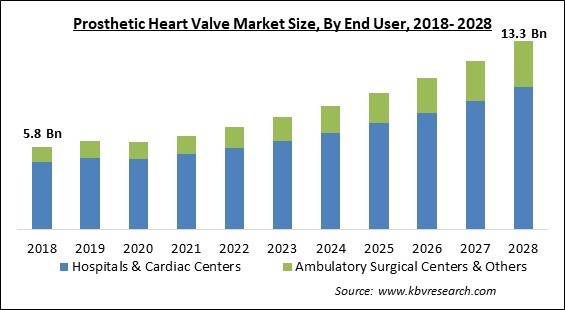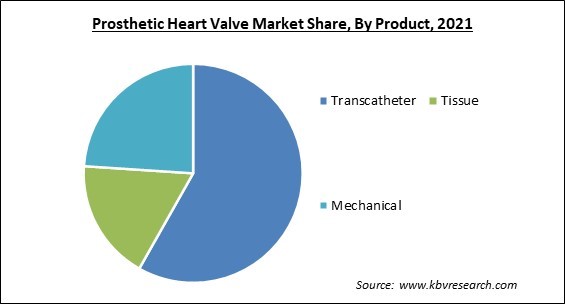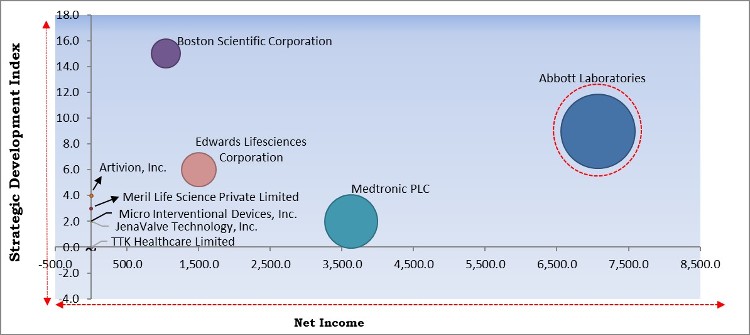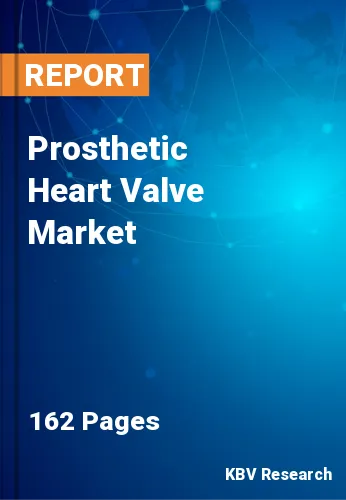The Global Prosthetic Heart Valve Market size is expected to reach $13.3 billion by 2028, rising at a market growth of 10.7% CAGR during the forecast period.
Materials like titanium and carbon are used to make mechanical heart valves. They are typically made up of two leaflets and a metal ring encircled by a knitted fabric ring that is sewed onto the heart in place of the native valve. Aortic and mitral replacement operations are available in a variety of models. Mechanical valves have the advantage of being extremely durable. These valves, on the other hand, provide a substrate on which blood clots can easily form.

An opening through which blood flows and a device that closes and opens the orifice make up artificial heart valves. Mechanical devices made of synthetic materials and biological or tissue valves made of animal or human tissue are the two forms of artificial heart valves. Biological valves are typically employed in people over the age of 65 who are unable to take anticoagulants. Mechanical valves are advised for individuals under the age of 40 who have a mechanical valve at another position, have had a stroke, or require double valve replacement. These valves necessitate the use of anti-coagulants by the patient. Mechanical valves can be classified into three categories based on how they open and close.
A revolving ball, a tilting disk, or two semispherical hinged leaflets are examples of these systems. The first is based on a ball-in-cage design, which employs a rubber ball that oscillates within a cobalt-chromium alloy metal cage. When the valve opens, blood flows between the ball and the housing through a primary and secondary orifice. A circular disk is held in place by wire-like arms that protrude into the orifice in the tilting disk valve.
The primary orifice is divided into two unequal orifices when the disk opens. A hinge mechanism connects two semicircular leaflets to the orifice enclosure in the current configuration. During the opening process, the leaflets separate, resulting in three flow zones in the center as well as on the sides.
During the pandemic, surgeries were delayed and production of prosthetic heart valves was also decreased or suspended due to government restrictions and limitations, causing the prosthetic heart valve market to experience a drop in the growth during the first wave of COVID-19. Coronaviruses are a wide family of SARS (severe acute respiratory syndrome) viruses that cause illnesses ranging from ordinary cold to serious respiratory illnesses. The execution of lockdown postponed the surgical operation for implanting a prosthetic heart valve as well as the manufacturing of prosthetic heart valves, resulting in gradual market disruption.
With the rapidly evolving lifestyles of people across the world, the occurrence of various diseases and disorders is also rising as a result. One of the major disorders that can be caused by the changing living patterns of people is cardiovascular disease. Unhealthy food, physical inactivity, cigarette consumption, and problematic alcohol consumption are the major behavioral risk factors for heart disease and stroke. People may experience symptoms, such as high blood pressure, high blood glucose, high blood lipids, or overweight or obesity as a result of behavioral risk factors. These intermediate risk factors are detectable in primary care settings and imply a higher risk of stroke, heart attack, heart failure, and other consequences.
The geriatric population all over the world is significantly increasing. According to the United Nations Organization, in 2019, the world's population of people aged 65 and up totaled 703 million. In 2050, the number of geriatric people is anticipated to reach 1.5 billion. The proportion of people aged 65 and up in the global population climbed from 6% in 1990 to 9% in 2019. By 2050, that percentage is expected to climb to 16%, implying that one in every six individuals worldwide would be 65 or older. In the years 2015-2020, a 65-year-old person should expect to live an additional 17 years on average over the world.
Mechanical heart valve failure occurs in various cases after the completion of an artificial heart valve transplant. Though structural damage is uncommon, infections and blood clots may necessitate the replacement of some of them. Clots can either open or seal the mechanical valve, causing stenosis, insufficiency, or a combination of the two. Some clots can break free from the prosthetic valve and move to the arteries and blood vessels that supply the heart (coronary arteries) or the brain (carotid arteries), resulting in a stroke or heart attack. Mechanical heart valves have a higher risk of thrombotic or thromboembolic consequences.

Based on End User, the market is segmented into Hospitals & Cardiac Centers and Ambulatory Surgical Centers & Others. In 2021, the Hospitals & Cardiac Centers segment witnessed the largest revenue share of the prosthetic heart valve market. The rapid surge in the growth of the segment is owing to the demand for expert and professional care during valve replacement surgeries. Due to the fact that, hospitals are more advanced and comprise more devices, equipment, and resources, the growth of this segment is significantly being augmented.
Based on Product, the market is segmented into Transcatheter, Tissue, and Mechanical. In 2021, the mechanical heart valve segment procured a significant revenue share of the prosthetic heart valve market. The rising growth of the segment is attributed to the robust stability and endurance of this kind of artificial heart valve. To offer mechanical stability and endurance, mechanical heart valves (MHV) are built entirely of non-biological (artificial) materials, such as pyrolytic carbon, titanium, cobalt, and polymers.
| Report Attribute | Details |
|---|---|
| Market size value in 2021 | USD 6.6 Billion |
| Market size forecast in 2028 | USD 13.3 Billion |
| Base Year | 2021 |
| Historical Period | 2018 to 2020 |
| Forecast Period | 2022 to 2028 |
| Revenue Growth Rate | CAGR of 10.7% from 2022 to 2028 |
| Number of Pages | 162 |
| Number of Tables | 253 |
| Report coverage | Market Trends, Revenue Estimation and Forecast, Segmentation Analysis, Regional and Country Breakdown, Competitive Landscape, Companies Strategic Developments, Company Profiling |
| Segments covered | Product, End User, Region |
| Country scope | US, Canada, Mexico, Germany, UK, France, Russia, Spain, Italy, China, Japan, India, South Korea, Singapore, Malaysia, Brazil, Argentina, UAE, Saudi Arabia, South Africa, Nigeria |
| Growth Drivers |
|
| Restraints |
|
Based on Regions, the market is segmented into North America, Europe, Asia Pacific, and Latin America, Middle East & Africa. In 2021, Asia-Pacific registered a substantial revenue share of the prosthetic heart valve market. The rapidly increasing growth of the regional market is owing to the rising geriatric population of the region. Moreover, due to an increase in the prevalence of cardiac disorders, like aortic stenosis, developing healthcare infrastructure in regional countries, such as China and India, and market players' constant focus on investing in emerging markets, the healthcare industry of the region is increasingly developing.
Free Valuable Insights: Global Prosthetic Heart Valve Market to reach USD 13.3 Billion by 2028

The major strategies followed by the market participants are Acquisitions. Based on the Analysis presented in the Cardinal matrix; Abbott Laboratories is the major forerunner in the Prosthetic Heart Valve Market. Companies such as Boston Scientific Corporation, Medtronic PLC and Edwards Lifesciences Corporation are some of the key innovators in the Market.
The market research report covers the analysis of key stake holders of the market. Key companies profiled in the report include Boston Scientific Corporation, Medtronic PLC, Abbott Laboratories, Meril Life Science Private Limited, Colibri Heart Valve LLC, Artivion, Inc., TTK Healthcare Limited, Edwards Lifesciences Corporation, JenaValve Technology, Inc., and Micro Interventional Devices, Inc.
By End User
By Product
By Geography
The prosthetic heart valve market size is projected to reach USD 13.3 billion by 2028.
Rising prevalence of cardiovascular diseases are driving the market in coming years, however, risk of valve failure limited the growth of the market.
Boston Scientific Corporation, Medtronic PLC, Abbott Laboratories, Meril Life Science Private Limited, Colibri Heart Valve LLC, Artivion, Inc., TTK Healthcare Limited, Edwards Lifesciences Corporation, JenaValve Technology, Inc., and Micro Interventional Devices, Inc.
The expected CAGR of the prosthetic heart valve market is 10.7% from 2022 to 2028.
The Transcatheter segment is leading the Global Prosthetic Heart Valve Market by Product in 2021, and would continue to be a dominant market till 2028; thereby, achieving a market value of $7.56 billion by 2028.
The North America market dominated the Global Prosthetic Heart Valve Market by Region in 2021, and would continue to be a dominant market till 2028; thereby, achieving a market value of $4,862.8 million by 2028.
Our team of dedicated experts can provide you with attractive expansion opportunities for your business.

